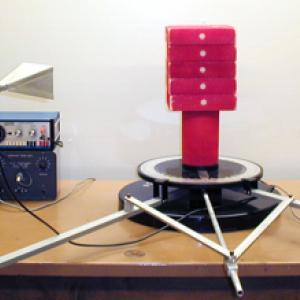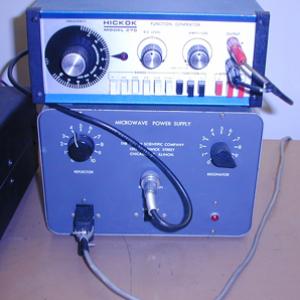College of Liberal Arts & Sciences
7A60.50 - Mu Wave Demo - Bragg Diffraction Planes
Assemble the demonstration as shown. The wave generator is plugged into the microwave power supply and the supply into the microwave tube/transmitter. The Hickok 270 wave generator seems to work best with this setup. The wave generator must be set with the Sine Wave at 0 - attenuation and from between 100 and 800 Hz. Plug the microwave receiver into the amplifier and speaker. Allow about 2 to 5 minutes for the system to warm up. The slightest movements of the Resonator and Reflector knobs on the microwave power supply will cause this unit to either work or not work so allow plenty of time for advanced preparation to check things out before taking into the classroom. Crystal patterns may be shown and diffraction angles can be measured.
- Tom Ekkens, "Low-Cost Methods for Improving Data Collection Speed in Microwave Bragg Diffraction", TPT, Vol. 60, #8, Nov. 2022, p. 686
- George R. Mitchell, "Correction Please", TPT, Vol. 22, # 3, Mar. 1984, p. 138.
- Earl Zwicker, "The Column Editor Replies", TPT, Vol. 22, # 3, Mar. 1984, p. 138.
- Thomas A. Mitchell, "Braggs Law In A Ripple Tank", TPT, Vol. 16, # 4, Apr. 1978, p. 243.
- Sir Lawrence Bragg, "The History of X-Ray Analysis", TPT, Vol. 3, # 7, Oct. 1965, p. 295.
- Joseph C. Amato, Roger E. Williams, "Rotating Crystal Microwave Bragg Diffraction Apparatus", AJP, Vol. 77, # 10, p. 942, Oct. 2009.
- M. T. Cornick, S. B. Field, "Microwave Bragg Diffraction in a Model Crystal Lattice for the Undergraduate Laboratory", AJP, Vol. 72, # 2, Feb. 2004, p. 154.
- Benjamin S. Perkalskis and J. Reuben Freeman, "Demonstrating Crystal Optics Using Microwaves on Wood Targets", AJP, Vol. 63, #8, Aug. 1995, p. 762.
- Thomas D. Rossing, Rodney Stadum, Douglas Lang, "Bragg Diffraction of Microwaves", AJP, Vol. 41, #1, Jan. 1973, p. 129.
- S. I. Salem et al. "Determination of Avogadro's Number (An Experiment.)", Am. J. Phys. 466, Vol. 56, No. 5, May 1988.
- A. Olah and J. W. Doane, "Experiment in the Bragg Reflection of Light for the Undergraduate Using Cholesteric Liquid Crystals", AJP, Vol. 45, #5, May 1977, p. 485.
- George Bradley and Jacob Dewitt, "Models for Microwave Analogs of Bragg Scattering", AJP, Vol. 36, #10, Oct. 1968, p. 920.
- John J. Connelly, Jr., "Simply Constructed Atomic Stacking Models for Microwave Diffraction Experiments", AJP, Vol. 36, #6, June 1968, p. 559.
- R. Hine, "Elementary Derivation of the Bragg Equation", AJP, 33, # 11, Nov. 1965, p. 962.
- T. G. Bullen, "An Improved Mounting for the Welch-Bragg Diffraction Apparatus", Apparatus Notes, July 1965-December 1972, p. 90.
- George Bradley, Jacob Dewitt, "Models of Microwave Analogs of Bragg Scattering", Apparatus Notes, July 1965-December 1972, p. 77.
- John J. Connelly, Jr., "Simply Constructed Atomic Stacking Models for Microwave Diffraction Experiments", Apparatus Notes, July 1965-December 1972, p. 66.
- Harry F. Meiners, "Microwave Bragg Diffraction Apparatus", The Welch Scientific Company.
- W. Kockelmann, A. Kirfel, S. Siano and C. D. Frost, "Illuminating the Past: The Neutron as a Tool in Archaeology", Physics Education, Vol. 39, (2), 2004, p.155.
- W. Bolton, "The Three-Dimensional Diffraction of Microwaves", Book 2 - Waves and Particles, Physics Experiments and Projects, 1968, p. 37-38.
- W. Bolton, "Refraction of Waves by "Atoms"", Book 2 - Waves and Particles, Physics Experiments and Projects, 1968, p. 39-40.
Disclaimer: These demonstrations are provided only for illustrative use by persons affiliated with The University of Iowa and only under the direction of a trained instructor or physicist. The University of Iowa is not responsible for demonstrations performed by those using their own equipment or who choose to use this reference material for their own purpose. The demonstrations included here are within the public domain and can be found in materials contained in libraries, bookstores, and through electronic sources. Performing all or any portion of any of these demonstrations, with or without revisions not depicted here entails inherent risks. These risks include, without limitation, bodily injury (and possibly death), including risks to health that may be temporary or permanent and that may exacerbate a pre-existing medical condition; and property loss or damage. Anyone performing any part of these demonstrations, even with revisions, knowingly and voluntarily assumes all risks associated with them.

